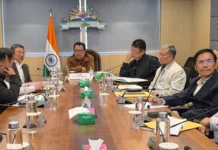[ Raysha Alvir ]
Today (Tuesday) marks the third anniversary of the Elopa-Etugu Community Eco Cultural Preserve (EECEP), a community-conserved area (CCA) of 75 sq kms situated in Lower Dibang Valley district.
The CCA was declared in June 2022 and stands as a milestone in the resurgence of culture, ancestral ties and a firm resistance against colonial legacies of enclosures and bureaucratic control. “CCA is a new term but a practised concept. It’s a technical name given to something which is already in our culture,” says Eja Pulu, one of the coordinators of the EECEP. “Nature and culture are not different from each other in our community.”
A living model of indigenous conservation
Conservation is not a borrowed Eurocentric idea for the Idu Mishmi community but an intrinsic aspect of life. “We never had any word for ‘conservation’ in our language,” notes Eja. “Because it was never separate from nature.”
The foundational principle of the CCA is not only the protection of biodiversity in isolation but it is also an effort to preserve the reciprocal relationship between the Idu Mishmi community and the natural world.
The CCA, which spans two culturally significant areas, Etugu (of the Menda clan) and Elopa (of the Pulu, Mitapo, and Linggi clans) is managed by a non-hierarchical community structure and responsibilities are shared collectively. It is made up of community rangers, researchers, elders, and community-nominated representatives and coordinators. The coordinators handle planning, and organise community events, learning journeys and administrative tasks such as planning, budgeting and accounts, while the rangers also take on multiple roles: they serve as nature guides, assist researchers and tourists in the field, and ensure security across the CCA. Transgressions by non-members are handled internally through the Idu traditional system of mediation, and fines, imposed as a form of restitution. The offences are also categorised, and higher fines are levied for more serious violations,such as hunting.
The CCA has also become a sustainable livelihood model. Entry fees (Rs 500 for non-Idus, Rs 20 for Idu Mishmi community members), research permits, and ecotourism have brought in revenue, without compromising community ownership.
“Forests must be protected, but it’s equally important that the communities who safeguard them also share in their benefits” says Jibi Pulu. “Now, we protect and also generate income. Our people are being trained as guides and storytellers. This is conservation with dignity.”
The Idu Mishmi rejection of top-down conservation is not an opposition to science but a critique of dominant frameworks that ignore Indigenous knowledge systems. “We use camera traps. We collect data. But we do it ourselves,” says Jibi Pulu. “The animals are protected not because of laws, but because they are our kin.”
The integration of traditional knowledge with scientific methods shows how the community members are attempting to strike a delicate balance. Camera trapping research in the EECEP is supported by the local Idu-led Dibang team (www.dibangteam.com), which works towards locally-led bio-cultural conservation.
One such belief is in Misu: the concept that certain animals possess a spiritually dangerous spirit and may bring harm if disturbed or killed. The tiger, hoolock gibbon, along with certain species of owls and wild cats, are considered Misu. Because of this, tracking or tracing these animals is generally discouraged. However, to monitor wildlife populations and assess their count, methods like camera trapping and field patrols are used, which is carried out with cultural sensitivity.
Looking forward and envisioning tomorrow
Long before it was declared a CCA, the clan members had already resolved to keep these lands free from privatization or commercial ventures. Now, three years into its formal recognition, the CCA stands as an ecological initiative and as a cultural safeguard. “Our culture is made up of animals and their stories,” Eja emphasises.
The EECEP, building on three years of committed ecological and cultural stewardship, is now moving towards a deeper engagement. A key development in this direction is the launch of the Idu Mishmi Wilderness Programme (IMWP), which was initially conceptualised as an experimental initiative, and has now proved remarkably successful. It isn’t a typical wilderness training course – it is designed for those who want to learn hands-on about the natural world by combining Western science with deep interactions with the people who have lived and cared for it – the local community. Participants are able to experience human-nature relationships as lived by the Idu Mishmi and learn about the forest. The activities will include forest stays, camera-trapping demonstrations, and learning traditional techniques for setting traps within the understanding of ethical engagement.
As Abba Pulu, a community member and an assistant professor of geography at a regional college in Arunachal, emphasises, the intention is not to draw in large tourist groups, but to cultivate responsible, deeper, low-impact eco-tourism aligned with the community’s values and priorities.
The EECEP members, led by the Idu resident researcher Eha Tacho, are also engaged in research on the hoolock gibbon. They are tracking changes in the gibbon population while integrating oral histories and local knowledge systems, which illustrates the CCA’s commitment to blending scientific inquiry with traditional ecological knowledge. They are also conducting vegetation transect surveys to better understand the composition of the forest – which trees are found where and in what numbers – while gathering oral histories and stories of trees from elders. This information will also help in understanding the dietary ecology of the gibbon, including which tree species and fruits are most preferred. Infrastructure development such as watchtowers, tents, and ranger camps, inspired by traditional Idu Mishmi house architecture, is also underway, financed entirely through community contributions and revenue.
From vision to reality: A success story
According to Abba Pulu, two key indicators reflect that this initiative might be headed in the right direction: First, camera trap data reveal a steady increase in wildlife populations, most notably herds of hog deer in areas where only a few individuals were recorded prior to the formal declaration of the CCA in 2022. Second, there has been growing countrywide interest in the model, with researchers and visitors increasingly turning to the Elopa-Etugu Community Eco-Cultural Preserve as an example of effective, community-led conservation grounded in cultural values.
The path forward for Etugu-Elopa lies in this integration of tradition and technology, ecology and economy, community and autonomy. As the community model grows it offers a compelling alternative to dominant paradigms of conservation, one where protecting the forest also means protecting language, memory, spirits, and identity.
The EECEP receives external support from Nature Conservation Foundation (NCF) and its partners.[Alvir is a researcher at Chr Michelsen Institute, Norway, working on the project CONLAB (Conservation and Labour)]



